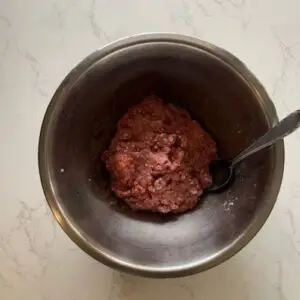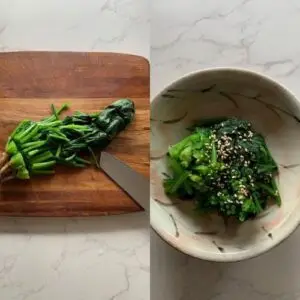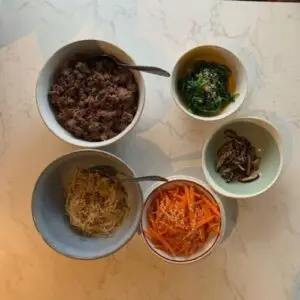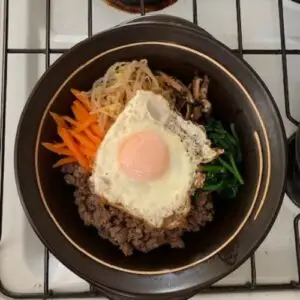How to Make Bibimbap— Korean Rice Bowl with Vegetables & Beef

Bibimbap: A Journey Through History—From Korean Royal Courts to Japanese Tables
I’ve never met a fellow Japanese person who doesn’t love Korean cuisine—and I’m certainly no exception. Whether it’s the vibrant, comforting flavors of Bibimbap or the spicy warmth of Sundubu Jjigae, Korean food has an irresistible appeal that keeps us coming back for more.
In fact, so many Japanese travelers visit South Korea just to indulge in its incredible food scene and immerse themselves in the culture. This deep appreciation made me curious: What makes Korean cuisine so universally loved in Japan as well as here in Australia? 🤔
That’s why I decided to dive deeper into the history and flavors behind one of Korea’s most iconic dishes—Bibimbap—and explore how it became a beloved staple on Japanese dining tables.

The Origins of Bibimbap: A Dish of Harmony
Bibimbap (비빔밥), meaning “mixed rice,” is one of Korea’s most iconic dishes—a vibrant bowl of rice topped with an array of colorful vegetables, protein, gochujang (fermented chili paste), and a runny fried egg. But where did this beloved dish come from?
Royal Roots & Peasant Origins
While bibimbap is now a staple in Korean cuisine, its exact origins are debated:
- Royal Cuisine Theory: Some historians believe it originated in the Joseon Dynasty (1392–1910) as a refined dish called goldongban (골동반), where leftovers from royal banquets were mixed with rice.
- Farmers’ Practical Meal: Others argue it was a humble peasant dish—farmers would mix rice with whatever seasonal vegetables they had, creating a quick, nutritious meal.
By the late 19th century, bibimbap became a widespread comfort food, evolving into the colorful, artfully arranged dish we know today.
Bibimbap Crosses the Sea: When Did It Come to Japan?
Korean cuisine, including bibimbap, entered Japan primarily through two major waves:
1. Post-WWII & the Korean Diaspora
After World War II (1945) and the Korean War (1950–1953), many ethnic Koreans (Zainichi Koreans) settled in Japan, bringing their food culture with them. Initially, Korean restaurants in Japan served dishes like kimchi and bulgogi, but bibimbap gained popularity later.
2. The 1980s–2000s: Korean Wave (Hallyu) Boom
The real surge in bibimbap’s popularity came with:
- 1988 Seoul Olympics – Increased global interest in Korean food.
- 2000s Korean Drama & K-Pop Craze – Shows like Winter Sonata and stars like BoA and BTS made Korean culture (and food) trendy in Japan.
- Health Food Trend – Japanese consumers embraced bibimbap for its balanced nutrition and vegetable-heavy profile.
Today, bibimbap is a common menu item in Japanese Korean restaurants, convenience stores (like 7-Eleven), and even bento boxes, often adapted with local twists (e.g., adding raw tuna or Japanese pickles).
Even though Australia has no shortage of great Korean restaurants, there’s something special about homemade food—don’t you think? That’s why today, I’m whipping up my own version of Bibimbap, packed with fresh ingredients and tailored to my taste. No takeout container can beat the joy of mixing it all together at the table!
Craving the perfect side? Try my homemade Kimchi Recipe – it adds just the right balance of spice and crunch to your Bibimbap!

Bibimbap Recipe – Korean Rice Bowl with Veggies & Beef
Ingredients
Meat with Marinade
- 200 grams beef mince/tender beef cut thinly
- 2 tbsp soy sauce
- 2 tbsp sesame oil
- 2 tsp sugar
- 1 tsp minced garlic
- 1/2 tsp sesame seeds
Vegetable, Eggs and Rice
- 250 grams spinach
- 400 grams bean sprouts
- 4 dried shiitake mushroom
- 150 grams carrots
- 4 eggs
- 4 cups short gran cooked rice if available
- neutral oil
- toasted sesame seeds
Spicy Bibimbap Sauce
- 3 tbsp gochujang
- 1 tbsp sesame oil
- 2 tsp sugar
- 1 tbsp water
- 2 tbsp vinegar
- 1 tsp minced garlic
- 1 tsp toasted sesame seeds
Instructions
Meat
- Mix the beef mince and marinade mixture, marinate the beef for at least 30 minutes

- Cook the meat over high heat for 3–5 minutes, until fully cooked.

Bibimbap Sause
- While the beef is marinating, mix all the sauce ingredients.

Sauteed Vegetable
Carrots
- Rinse, peel, and julienne the carrots. In a hot wok, add a tablespoon of oil and stir-fry the carrots over medium-high heat for 2–3 minutes. Sprinkle in about 1/4 teaspoon of salt and give it a quick toss.

Spinach
- Wash and clean spinach in cold water.Boil water with 1 tsp salt, blanch spinach for 30 sec.Drain, rinse in cold water, and gently squeeze out excess water.Cut into 3-4 pieces Mix with 1/2 tsp minced garlic, 1/4 tsp salt, 1/2 toasted sesame seeds and 1tbsp sesame oil

Bean Sprout
- Rinse sprouts, discard bad beans.Boil salted water, blanch sprouts for 1-2 min.Drain, rinse in cold water, and gently squeeze dry.Toss with 1/2 tsp minced garlic, 1 tbsp soy sauce, 1 tbsp vinegar, 1/2 toasted sesame seeds and 1tbsp sesame oil

Eggs
- Make sunny side up eggs
Assembling
- Scoop rice into a large bowl. Arrange the prepared vegetables and beef neatly on top. Crown with a fried egg if desired. Serve with sauce.

- For dolsot bibimbap: Heat a stone or earthenware bowl over medium heat and lightly coat with a teaspoon of sesame oil. Add cooked rice, arrange toppings neatly, and cook for a few minutes until the rice crisps at the edges and sizzles."


Love this recipe! Thank you!
Thank you so much! It really means a lot to know someone enjoyed the recipe I love making myself 🥰